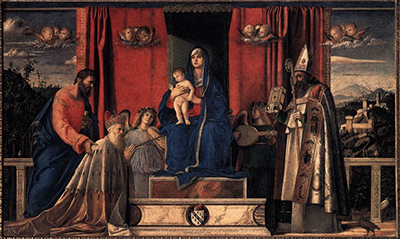Barbarigo Altarpiece is a painting that represents Madonna and Child, St. Augustine, St. Mark, musician angels, and Agostino Barbarigo who is kneeling.
At the centre of the Virgin's throne is a date and sign that dates back to 1488 that says "IONNES BELLINVS 1488". This painting was created through oil on a 200x320 canvas. The painting is among the few paintings that Giovanni Bellini painted in his career.
Dog Agostino Barbarigo, who was the person who commissioned it, belonged to an important Venetian aristocracy. He was an important person in the history of the Republic who succeeded Marco, his elder brother to the dogate. At one point, Agostino and his brother Marco had a furious public argument, that upon the death of Marco, Agostino was held responsible for the death of his brother.
To show the people that he was the loyal continuer and heir of the actions of his brother, he promoted several artistic commissions publicly in his first year in office. Some of the paintings he commissioned include the Torre Dell’Orologio of Mauro Codussi, the Scala dei Ginanti, and others. These paintings were placed for the hegemonic image of Venice, parallel with Marco’s political ideas.
In private, he commissioned Gentile Bellini to paint Marco’s portrait, and he entrusted Giovanni Bellini to paint the large altarpiece which was a gift of expiation for the moral debt he had. Agostino placed the altarpiece in the main hall of the family palace, and after his death in 1501, the painting was left to the women’s monastery at Murano called Santa Maria degli Angeli.
Agostino believed that the canvas of the lady figure belonged to a high altar in the church. He also believed that none of his 5 children and grandchildren needed to put the painting in their massive house, nor in any other location other than in the monastery. The paintings stayed for some years in the monastery, but later on, the canvas was moved to the church of San Pietro Martire, Murano, where it resides to date.




